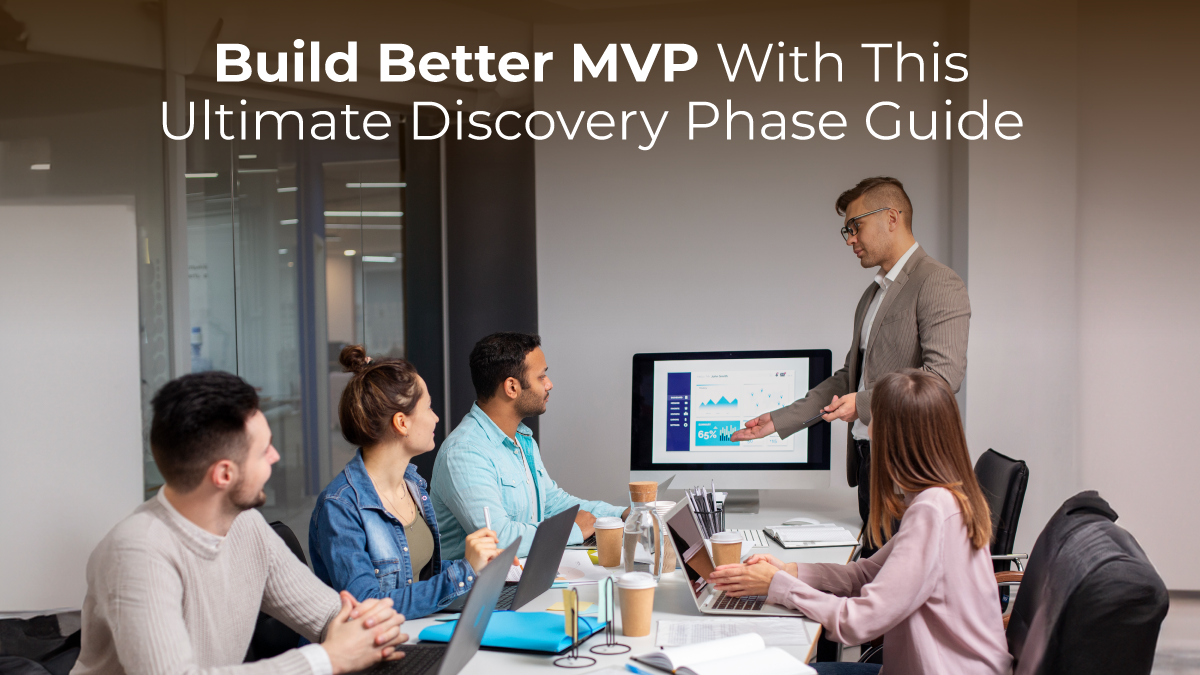Build Better MVP With This Ultimate Discovery Phase Guide

The software development lifecycle (SDLC) is a structured process adopted by the software industry to design, develop, and test high-quality software. This systematic approach ensures adherence to defined processes throughout various phases, enhancing software quality and reducing development costs. One of the most crucial phases is the discovery phase, especially when developing a Minimum Viable Product (MVP).
The discovery phase sets the tone for the entire development process. It involves collecting detailed requirements, understanding user needs, identifying key features, and planning the project’s scope and strategy. Properly executing this phase ensures a clear project direction and shared understanding among all stakeholders, setting the stage for a focused and successful MVP.
However, neglecting or rushing through the discovery phase can lead to adverse outcomes. Typically, oversight during the discovery phase can cause significant delays and resource wastage, ultimately jeopardizing the project’s success by delivering an MVP that fails to meet the intended business concept. So, let’s jump in and take a close look at this complete guide detailing the discovery phase for software development.
What is the Discovery Phase?
The discovery phase, also known as the scoping phase, is the initial stage of a software development project. It builds the foundation for the entire project by gathering information, defining goals, and identifying potential challenges. It is a critical initial step in the software development lifecycle, particularly when developing a Minimum Viable Product (MVP).
This phase is dedicated to gathering and analyzing all necessary information to ensure a clear and viable blueprint for the project. Its primary goal is to minimize uncertainties and align the development team’s efforts with the specific needs and objectives of the business. Thus, it sets the tone for the project. The discovery phase has several key objectives with a focus on MVP development.
- Understanding project goals and business needs in the context of the MVP- It involves detailed discussions with all the stakeholders to capture the MVP’s vision, objectives, and expected outcomes, ensuring that it is strategically aligned with the business goals.
- Defining target audience and user personas to inform MVP functionalities—This involves identifying and defining user personas that represent the MVP’s end-users to design relevant and appealing functionalities for them.
- Identifying core features for the MVP that validate user needs and market fit— It includes the minimum features needed to satisfy early adopters and validate that the product meets a real-world need, resulting in faster ready-to-market time.
- Assessing technical feasibility and potential risks for the MVP’s development— This includes analyzing the development team’s current technology stack, infrastructure, and technical capabilities.
- Establishing a timeline and resource estimate for building the MVP – It includes detailing the scope of work, scheduling key milestones, and allocating the necessary budget and human resources to execute the plan.
Benefits of a Thorough Discovery Phase for a Successful MVP
The discovery phase is critical to the software development life cycle and MVP development process. It offers numerous benefits that help reduce risks, align stakeholders, and save costs. Further, it ensures that the MVP is truly user-centered. This phase sets the stage for the successful development and launch of a viable product in the market, which is positioned for growth and improvement in subsequent iterations. Thus, there are numerous benefits of the discovery phase done right.
- Increased project clarity and focus – A thorough discovery phase is integral to defining a clear and concise vision for the Minimum Viable Product (MVP). It serves as a guide for all development efforts. This way, the development team can focus their efforts and resources on the most critical aspects of the MVP by setting clear business objectives, target customer segments, and key functionalities. This focused approach enhances the efficiency and effectiveness of the project.
- Improved stakeholder alignment – The discovery phase is crucial in software development projects, as it aligns all stakeholders with the MVP’s intended purpose and functionalities. Comprehensive discussions and collaborative planning sessions help set expectations and build consensus around the vision and strategic goals of the MVP. This is critical as it ensures everyone, from developers to investors, understands their roles and the expected outcomes. Thus, it promotes better collaboration and minimizes conflicts during the development process.
- Reduced project risks – Conducting a thorough discovery phase helps identify and address potential risks early in the software development project lifecycle. The team can develop strategies to tackle risks by anticipating technical, market, and resource-related challenges that could impact the MVP. Thus, the discovery phase in software development enables proactive risk management, preventing costly interruptions and setbacks. Further, it increases the chances of success by preparing the team to handle unexpected issues efficiently.
- Enhanced cost-effectiveness – A well-executed discovery phase contributes significantly to the cost-effectiveness of developing an MVP. The team can prioritize essential features by thoroughly understanding user needs and market demands. It helps avoid wasting resources on unnecessary or less impactful functionalities. Prioritizing essentials helps minimize costly revisions and rework later in the development process. Thus, the discovery phase ensures that the MVP is both budget-friendly and high-impact.
- Stronger foundation for user-centered design – The discovery phase involves deep research into user behaviors, needs, and preferences, guiding the MVP’s design and functionality. Thus, it is crucial for laying the groundwork for a user-centered design approach. The development team can ensure that the MVP will effectively address real user problems by validating the user insights before any code is written. As a result, it enhances user satisfaction and adoption rates.
- Informs the development of a successful MVP – Ultimately, the insights gathered during the discovery phase help make informed decisions throughout the development of a successful MVP. This phase ensures that the product is strategically positioned to solve user’s problems from the outset. This increases the adoption rate by offering immediate value to users and meeting their expectations. Moreover, a well-planned MVP is better equipped to gather helpful feedback from its early users. This is invaluable in iterating and refining future versions of the product.
Key Activities During the Discovery Phase, Focusing on MVP Development
Several vital activities are integral to a successful discovery phase. These help ensure that the MVP development is well-informed, strategically planned, and designed to meet the real needs of users while being feasible and technically sound.
Requirements gathering: Requirements gathering is pivotal during the discovery phase to lay a solid foundation for the MVP. It involves a series of user interviews, workshops, and competitor analysis to understand the target users’ needs, issues, and the existing market landscape. It also enables direct engagement with potential users to gather evidence-based insights. This drastically reduces complexities in software development.
Competitor analysis also plays a crucial role, providing a clear picture of the market standards and innovations. It helps identify areas where the MVP can differentiate itself. The data collected during these activities will help decide the functionalities and features that will make the MVP valuable to its intended users.
MVP feature prioritization: After gathering requirements, the next crucial step of the discovery phase is MVP feature prioritization. It involves identifying and focusing on the core functionalities essential for the product’s market fit and user needs. The goal is to determine the minimum set of features that the MVP needs to solve the user’s problem and deliver value effectively.
It also needs to stand out in the competitive landscape. The prioritization process ensures efficient resource use and focuses development efforts on building a lean product that addresses the most critical aspects of the user experience.
Feasibility analysis: Feasibility analysis is another critical activity in the discovery phase. It assesses whether the prioritized MVP features are technically and financially viable within the given constraints, such as existing infrastructure, budget, and resources. It involves detailed discussions with technical leads to explore the potential challenges and solutions in implementing the features.
Understanding these limitations early in the software development cycle is essential for making informed decisions and ensuring that MVP development is on a practical and achievable path.
Technical architecture exploration: Defining a high-level system architecture is essential for supporting the MVP’s functionalities. This process involves outlining the technical requirements and making critical decisions regarding the software’s architecture. The goal is to create a scalable, maintainable system capable of supporting the MVP with the possibility of future growth.
This step is crucial in determining the most suitable technologies, frameworks, and platforms that meet the project’s objectives and technical requirements.
User experience (UX) design exploration: The UX design exploration happens parallel to the technical exploration. It outlines the user’s journey and interaction with the MVP. This phase involves creating low-fidelity prototypes and wireframes focusing on the MVP’s core functionalities. These visual and interactive representations are invaluable for visualizing how users interact with the product.
It is further helpful in validating design choices through user feedback. They bridge user needs and the final product, ensuring the user experience is intuitive and aligned with user expectations.
Project estimation and planning: The discovery phase includes project estimation and planning. It involves estimating preliminary timelines, resource allocation, and cost. This planning outlines a roadmap for the MVP build, setting the stage for the entire development process. Beyond allocating the necessary human and financial resources, it also involves determining the project scope and scheduling key milestones.
An effective project plan ensures that the development team has a clear direction and adequate resources to deliver the MVP on time and within budget.
Who is Involved in the Discovery Phase?
Another aspect of the discovery phase is identifying the key stakeholders associated with software development projects for better collaboration. All these critical stakeholders in the discovery phase ensure a comprehensive understanding of the project’s business and technical aspects. This collaborative approach enriches the planning and development process and significantly enhances the likelihood of the MVP’s success in the market.
Here is a list of familiar stakeholders involved in most projects.
- Product owners/business stakeholders – Adequate involvement of product owners and business stakeholders is crucial during the discovery phase. They are mainly responsible for conveying the business goals, vision, and objectives for the MVP to other stakeholders involved in the software development process. Their comprehensive knowledge of market demands, business strategy, and competitive conditions guarantees that the MVP aligns with broader business aims, tapping into actual market opportunities. These stakeholders frequently link the business aspect and the development team, offering vital insights determining the project’s scope and direction.
- Project managers – Project managers play a vital role in the discovery phase. They organize and lead discussions, ensuring that everyone’s perspectives are considered. They make sure all participants clearly understand the project’s scope and objectives. Their core responsibility includes managing timelines and resources and ensuring the discovery phase progresses as planned. They achieve this by maintaining a structured approach to scheduling and resource allocation. Thus, project managers help prevent scope creep and ensure that the project stays within its budget and meets its deadlines.
- Developers—During the discovery phase, developers evaluate the MVP’s technical feasibility. Considering the existing technology stack, available technical resources, and time constraints, they offer crucial insights into what can realistically be achieved. This team ensures that the MVP’s planned features are technically executable. Their expertise is essential for identifying potential technical risks early in planning and suggesting practical solutions.
- UX/UI designers and architects – UX/UI designers are responsible for developing user-centered design concepts for the MVP during the discovery phase. They concentrate on how end-users interact with the MVP, ensuring the product is intuitive, accessible, and visually appealing. Architects, on the other hand, focus on the overall system architecture and technical structure required to support the MVP’s functionalities. UX/UI designers create prototypes, which are utilized to validate and refine the product’s design through stakeholder feedback and user testing. Their work ensures that the MVP operates effectively and delivers a smooth and visually engaging user experience.
- End users (if possible) – Products are made for end users. Thus, their participation is beneficial in the discovery phase. It offers direct insights into their needs, preferences, and expectations for the MVP. Engaging with end users can be done through several methods, such as interviews, surveys, or workshops. However, it is equally important to evaluate and take corrective measures based on the feedback obtained from these interactions. It helps to ensure that the MVP will effectively meet the requirements of its intended audience, thereby enhancing the likelihood of its successful adoption and user satisfaction.
Deliverables of the Discovery Phase: Paving the Way for the MVP
The discovery phase has several expected deliverables, collectively ensuring that the MVP development process is well-organized and focused on creating a product that effectively meets user needs while being technically robust and scalable. These deliverables lay the groundwork for smoothly transitioning from the discovery phase to the MVP’s design and development phases.
- Project vision document: One of the primary deliverables of the discovery phase is the project vision document. It outlines the project’s overarching goals, identifies the target audience, and describes the key functionalities that the MVP will include. The vision document serves as a strategic guide for all stakeholders, ensuring everyone clearly understands the project’s objectives and what the MVP aims to achieve. This document often also includes insights into the market need that the MVP addresses, the business opportunity it represents, and the expected outcomes of launching the MVP.
- User personas: User personas are detailed, fictional representations of the MVP’s target users based on user research and data collected during the discovery phase. They include several details, such as demographics, behaviors, preferences, needs, challenges, and motivational factors. User personas help the development team and designers understand who they build the MVP for. It guides the creation of a product that resonates with its intended users.
- User stories and user flows: User stories and flows are narrative descriptions and visual diagrams describing how users will interact with the MVP. User stories express and define what the user wants to achieve using the MVP and why. User flows complement these stories by mapping out a user’s steps to complete a task within the MVP. It highlights the interactions that need to be designed and developed. These deliverables are essential for prioritizing the development of core functionalities most important to the user’s experience and success with the MVP.
- MVP feature specification document: The MVP feature specification document lists MVP’s core functionalities in detail. It contains the features identified as essential for the MVP to function effectively and meet the initial market and user needs. Further, it details the requirements for each feature, how they interact, and their priority levels. This specification acts as a blueprint for developers. It ensures everyone understands what needs to be built and how features should work together to create a seamless product.
- High-level technical architecture: Another critical deliverable is a high-level technical architecture document. It outlines the technologies, platforms, and system design supporting the MVP. This document includes information on the software architecture, data flows, integration points, and any third-party services the MVP will utilize. The technical architecture ensures that the MVP’s design is scalable, maintainable, and capable of evolving as the product grows based on user feedback.
- MVP development roadmap: Finally, the MVP development roadmap provides a preliminary timeline for building the MVP. It includes all significant details about the key milestones, phases of development, testing periods, and planned release dates. This roadmap helps manage stakeholder expectations and ensures the project team has a clear schedule to guide their work. It also serves as a tool for tracking progress and adjusting as needed throughout development.
Common Challenges and How to Overcome Them
The discovery phase can set a solid foundation for developing a successful MVP. However, businesses must address common challenges with strategic planning and active stakeholder engagement. This approach mitigates risks and enhances the likelihood of the MVP effectively meeting its intended goals.
- Scope creep – Scope creep is a common issue in the discovery phase. It happens when new features or requirements are added without proper evaluation. It can shift the MVP’s focus and delay its development. To prevent scope creep, it’s crucial to clearly define what the MVP will do and establish strict boundaries, concentrating on the essential functionalities needed for the MVP’s market validation.
- It’s essential to manage stakeholder expectations by explaining that the MVP aims to test hypotheses and learn from a minimal set of functional features. Based on the MVP’s success and feedback, developers can plan for additional features and improvements for future versions.
- Incomplete requirements for the MVP—Another challenge during the discovery phase is often gathering incomplete requirements, which can lead to delays and increased costs later in the software development process. Employing active requirement-gathering techniques such as user interviews, focus groups, and direct observation can address this issue. Involving end users early in the software development process can provide insight into the necessary functionalities and help clarify the MVP’s requirements. Tools like user story mapping can also effectively visualize the user’s journey and ensure that all critical paths are thoroughly understood and documented.
- Unrealistic deadlines for the MVP – Setting unrealistic deadlines for the MVP can lead to several issues, such as rushed work, lower quality outputs, and burnout among team members. It is one of the common challenges of the discovery phase in software development. Establishing clear communication between the project managers and stakeholders about what can be achieved within a given timeframe is essential to prevent this situation. At the same time, prioritizing a flexible yet realistic timeline allows for high-quality development that includes adequate testing and iteration. Agile methodologies can also help integrate changes and manage time effectively by breaking the project into smaller, manageable sprints that provide regular feedback and adjustment opportunities.
- Lack of stakeholder buy-in for the MVP concept – Lack of stakeholder buy-in can derail an MVP project before it even begins. This can be due to several reasons, from not understanding the purpose of an MVP to being skeptical about its potential value. To overcome this challenge, facilitate workshops, presentations, and regular meetings to educate stakeholders about the benefits of an MVP approach, such as faster time to market and reduced risk. Demonstrating how the MVP aligns with broader business goals and showing examples of successful MVPs can also help gain support. These sessions should be interactive and engaging, allowing stakeholders to express concerns and contribute ideas. It will promote a sense of ownership and commitment to the project.
- Lack of In-house Technical Expertise—On the other end of scope creep is knowing the technical expertise required to execute the MVP based on user information. Depending on the scope and technology requirements of the software development process, many companies might see a lack of in-house talent to execute the plan prepared during the discovery phase. Outsourcing software development services is a great option for balancing speedy execution, time savings, and finding the right talent. To manage this effectively, developers and project managers should set and follow clear project boundaries and effective communication right from the start. Regular communication with stakeholders is also essential to align expectations and agree on any changes collectively.
Investing in a Strong Discovery Phase: A Wise Decision for Your MVP
It is in great favor of businesses to invest time, energy, and effort in an intense discovery phase to create a sound strategy for anyone looking to develop an MVP. This phase ensures the MVP is built on a foundation of validated user needs and well-defined business objectives. It further significantly enhances the efficiency and effectiveness of the development process. The result of a thorough discovery phase is a product that is technically feasible, cost-effective, and tailored to meet the demands of the market and the expectations of its users.
Long-Term Benefits of a Comprehensive Discovery Phase – Investing in a thorough discovery phase is a strategic decision that brings substantial long-term benefits for developing a Minimum Viable Product (MVP). This initial phase lays the foundation for the project, ensuring that every part of the MVP, from design to development, is based on a clear understanding of user needs and business objectives.
A comprehensive discovery phase helps define the problem statement, align the project vision across all stakeholders, and establish clear, actionable goals. These steps are crucial for correctly guiding the development process, ultimately making the MVP effective in the market and successfully reaching its goals.
Positive Impact on MVP Development—The extent of the discovery phase dramatically influences the development of the MVP. Dedicating time and resources early on to understanding the market and user needs significantly reduces the complexity of the software development process. This phase focuses on essential functionalities necessary for the MVP’s success and eliminates features that do not contribute directly to the product.
Furthermore, by validating assumptions early on, teams can refine their strategies based on solid data rather than guesswork. This focused approach streamlines the development process, improves efficiency, and ensures that the MVP meets the critical needs of its target audience.
Potential Cost Implications – The upfront cost of a thorough discovery phase is small compared to the potential expenses of modifying a poorly planned MVP after development. The initial investment in the discovery phase can easily be set off by substantial savings later on. Investing sufficiently in the discovery phase helps prevent expensive reworks, scope creep, and wasted efforts due to unclear plans.
Moreover, the insights obtained during this phase allow for more precise budgeting and resource allocation, minimizing the chance of unforeseen expenses as the project advances.
Conclusion
The discovery phase is a crucial investment in the software development lifecycle, especially when developing a Minimum Viable Product (MVP). This initial stage lays the groundwork for the entire project, from start to finish. Thus, skipping or rushing through this phase can lead to increased costs, delayed timelines, and products that fail to meet user expectations or business needs.
In contrast, a well-conducted discovery phase can significantly mitigate risks, prevent unnecessary expenditures on extras, and elevate the overall quality and impact of the final product. Thus, businesses are encouraged to implement the discovery phase involving all stakeholders to promote dialogue, thorough information gathering, and visualizing the overall plan for software development.






